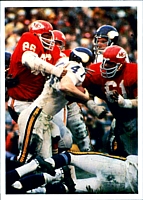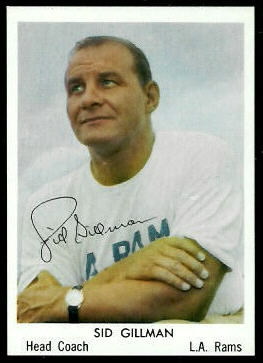
Super Bowl IV was an American football game played on January 11, 1970, at Tulane Stadium in New Orleans, Louisiana. It was the fourth and final AFL–NFL World Championship Game in professional football prior to the AFL–NFL merger taking effect the following season. The American Football League (AFL) champion Kansas City Chiefs defeated the National Football League (NFL) champion Minnesota Vikings by the score of 23–7. This victory by the AFL squared the Super Bowl series with the NFL at two games apiece as the two leagues merged after the game.

Sidney Gillman was an American football player, coach and executive. Gillman's insistence on stretching the football field by throwing deep downfield passes, instead of short passes to running backs or wide receivers at the sides of the line of scrimmage, was instrumental in making football into the modern game that it is today. He was inducted as a coach into the Pro Football Hall of Fame in 1983, and the College Football Hall of Fame in 1989.

Houston J. "Twine" Antwine was an American football defensive tackle who played in the American Football League (AFL) and National Football League (NFL) for 12 seasons.

John Daniel Matuszak, nicknamed "Tooz", was an American football defensive end in the National Football League (NFL) who later became an actor.

Junious "Buck" Buchanan was an American professional football defensive tackle who played for the Kansas City Chiefs in the American Football League (AFL) and National Football League (NFL). Buchanan was inducted into the College Football Hall of Fame in 1996 and the Pro Football Hall of Fame in 1990. Buchanan was massive for his era, standing at 6'7", and weighing 270 lbs. His height gave him a big advantage against lineman in the trenches.
Gerald Avery Mays was an American professional football player who was a defensive end for the Dallas Texans/Kansas City Chiefs. He played college football for the SMU Mustangs.

Robert Lorenzo Brazile Jr., nicknamed "Dr. Doom", is an American former professional football linebacker who played in the National Football League (NFL). Brazile played from 1975 to 1984 for the Houston Oilers and was inducted into the Pro Football Hall of Fame in 2018.
The 1975 NFL draft was held January 28–29, 1975, at the New York Hilton at Rockefeller Center in New York City, New York. With the first overall pick of the draft, the Atlanta Falcons selected quarterback Steve Bartkowski.
The 1968 NFL/AFL draft was part of the common draft, in the second year in which the NFL and AFL held a joint draft of college players. It took place at the Belmont Plaza Hotel in New York City on January 30–31, 1968.
The 1967 NFL/AFL draft was conducted March 14–15, 1967, at the Gotham Hotel in New York City. It was the first common draft between the NFL and the AFL, part of the AFL–NFL merger agreement of June 1966.
Raymond Daniel Saleaumua is an American former professional football player who was a defensive tackle in the National Football League (NFL). He played college football for the Arizona State Sun Devils and was selected in the seventh round of the 1987 NFL draft. He played in the NFL for the Detroit Lions, Kansas City Chiefs and Seattle Seahawks.

Jerry Martin Sherk is an American former professional football player who was a defensive tackle for the Cleveland Browns of the National Football League (NFL) for 12 seasons between 1970 until 1981. He made the Pro Bowl lineup for four straight years from 1973 through 1976, and is widely considered to be among the best defensive players in Cleveland Browns history.
The 1964 NFL draft was held in Chicago, Illinois, at the Sheraton Hotel & Towers on Monday, December 2, 1963.
The 1962 NFL draft was held on December 4, 1961 at the Sheraton Hotel in Chicago, Illinois.
Thomas Arthur Keating was an American professional football defensive tackle. He played college football for the Michigan Wolverines from 1961 to 1963 and played 12 seasons in the American Football League (AFL) and National Football League (NFL) from 1964 to 1975. He was an AFL All-Star in 1966 and 1967, a key to the 1967 Oakland Raiders' defensive line that led the team to a 13–1 record and the 1967 AFL Championship, and was considered "the premier tackle in the old American Football League". He was known for his use of a distinctive four-point stance in which he lined up with both hands on the ground.
Daniel Joseph Conners was an American professional football linebacker who played 11 seasons for the Oakland Raiders of the American Football League (AFL) from 1964 through 1969, and later in the National Football League (NFL) from 1970 through 1974. He played college football for the Miami Hurricanes and is enshrined in their Hall of Fame.
The 1971 Kansas City Chiefs season was the franchise's second season in the National Football League (NFL), ninth as the Kansas City Chiefs, and twelfth overall. They improved from a 7–5–2 campaign in 1970 to record a 10–3–1 mark and win the AFC West division championship, the Chiefs' first division title since 1966 and last until 1993. The Chiefs tied with the Miami Dolphins for the best record in the AFC and were tied for the third-best record overall in the NFL, trailing only the 11–3 marks of the Dallas Cowboys and Minnesota Vikings.








